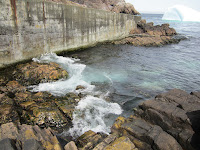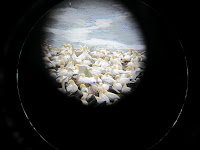Day 1:
Driving to the ferry in Cape Breton: some mountain
it takes 6 hours on a ferry to go from sydney to newfoundland, there was a nice view which quickly turned into fog..
Project outline: skip this if you don't care and just want to see pictures...
Little brown bats (Myotis Lucifugus) come together in the late spring to form “maternity colonies” which may consist of 10s to 100s of females that roost together. One colony may use multiple roosts and members will switch between roosts throughout the season. In Newfoundland, pups are likely born in late June or July and begin to fly at about 3 weeks of age. Our goal is to characterize and understand the factors that effect the social ecology of bats by measuring patterns of roost use. Given that they are long-lived (up to at least 34 years) and return to the same area each summer, it is not surprising that these animals are highly social and likely develop bonds with other individual bats that persist. In addition to sociality, perhaps temperature inside the box will affect where they roost, or maybe they prefer to roost with certain other bats. We also want to understand how the juveniles of the year fit into the colony: do they stay with their mother and grandmother or do they prefer to spend time with other juveniles? Do they spend the day sleeping with family and the evening with the other juveniles? Studies of genetic relatedness will assist us in assessing this. Do older females stay behind to watch the pups before they are able to fly while the mothers go out to hunt? In other bat species, such as Bechstein’s bats, researchers have found that colonies consist of multiple communities which persist over the years, but are kept as one colony due to the relationships between the older females of each community. Do little brown bats have communities? Or maybe they pick cooler bat boxes on hot days and warm bat boxes on cold days, regardless of who else is in the box. Hopefully this study will shed some light on these questions about the social behaviour of little brown bats.
Methods: Little brown bats were captured at Salmonier Nature Park and tagged with uniquely coded microchips (PIT tags) to permit individual identification. We have also placed readers on bat boxes to record when bats with microchips move into or out of the roost. Furthermore, inside each bat box we have placed temperature loggers which record temperature every 30 minutes, allowing us to have an idea of the microclimate inside so that we can compare roost temperatures to ambient. Studying little brown bats in Newfoundland is especially important since little browns have been affected by white-nose syndrome on the mainland. Starting in New York in 2006 and spreading through Canada, from Ontario to Nova Scotia, over 1 million little brown bats have died from this fatal fungus which affects the bats while hibernating. Newfoundland, being an island, may serve as a refuge for little browns, and thus white-nose syndrome may not affect the species here. Studying the bats here can thus give us an idea of the normal little brown behaviour and possibly help construct conservation approaches to help save the few that will remain after the fungus has destroyed most of the colony in affected areas.
Day 1&2: Study site 1
Pynn's brook
you can see the bat boxes in the trees - there are two trees which have two bat boxes in each... and a beautiful view off behind them
Looking up into the bat boxes to count bats... cannot see any in this photo
Conclusion: 106 bats captured in two nights, 76 in the first night, 30 on the second, not as many as we would have liked. Also found out there were 6 bat boxes when there was only supposed to be 4, so we didn't have enough recorders for all the bat boxes.
Day 3&4:
After Pynn's Brook we drove across the island to get to Salmonier Nature Park. Along the way we stopped at this place where they have built stairs for salmon to get around a man made dam.
Arrived at Salmonier Nature Park, beautiful place. Problem: supposed to be 4 bat boxes, only had 4 recorders, found 11 bat boxes...
But on the bright side, we found a piebald bat!
Jordi's better photos:
white toes!
Two nights of trapping at the park, caught 239 bats, bringing our total to 345, and we were only limited to that because we ran out of PIT tags. There were easily 500 bats there!
Day 5:
The next day we headed to St. John's, went up to signal hill:
the houses in st johns are pretty cute!
Iceberg in Quidi Vidi:
Last morning at Salmonier Nature Park. Ralph, the manager took me down to see the Cariboo which had just had a calf a few days earlier:
Day 6:
Driving to Cape Saint Mary's. Ended up stopping in Branch:
This stop was not by choice... we were driving and got a flat tire, so we placed the donut on and stopped in this little town which didn't even have street names. Someone there offered to fix it, but the fix wasn't great because we had driven on it too long before realizing it was flat. Then we were off again to cape saint mary's to see the seabird sanctuary... and pop, there went the tire again! back to the donut...
But we arrived at Cape Saint Mary's!
orange head birds-gannets, black - common murres, and the one in the middle with white on her beak - razorbill!
Day 7:
Drove across the island, back to the east coast. Arrived at Gros Morne provincial park in the evening... and it was so wild and beautiful that I wouldn't have been surprised if a velociraptor jumped out... it looked like the wild island from jurassic park.
Spent the evening by the seashore:



the garbage I had collected on my walk... how can you pollute such a beautiful thing as the ocean! ughh
Then that night I went out with one of my colleagues to see some live music. wow, lots of newfoundland accents, great times.
Day 8:
Then the tablelands! An area of land that used to be touching the earths mantle... but was flipped over, exposing rocks that are usually very deep into the ground... up to the surface!
hike later on in the forest by lomond river then to some waterfalls,
and off we go..


































































